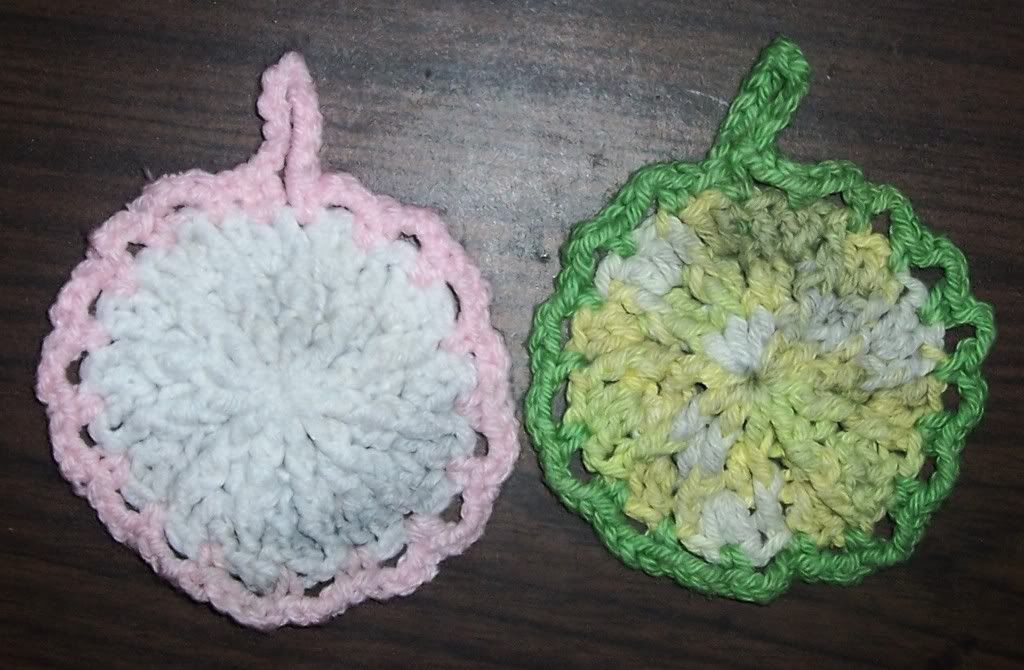Tawashi Revisited
Phase two of the contest of cotton vs acrylic was done yesterday afternoon. If you aren't familiar with the bout, just page down a bit and read yesterday's blog post.
After scrubbing the stove, the cotton tawashi was a hair above the acrylic contender. Mostly due to cotton's ability to absorb water.
Yesterday I tackled another big household task -- cleaning the bathroom. The cotton tawashi was used in the hallway kids'/visitors' bathroom. And the acrylic was used in the master bathroom.
Two Tawashi. Bleach. Orange oil cleanser.....
The outcome??
The acrylic tawashi was great for scrubbing problem areas (like hard water deposit on the tub spout, or soap scum from the shower tile. But, it again fell short in the finishing steps like wiping up grime, or water. I do, however, have to say that it was awesome at scrubbing the sink and shower handles clean. It was great for scrubbing baseboards. I used an old towel afterwards to wipe up any grime and water left after scrubbing, since the acrylic just can't absorb anything. The acrylic was also awesome to use with bleach (didn't affect the color or strength of the yarn at all) to scrub tile grout. And, orange oil cleanser also had no affect on the yarn. (Orange oil cleanser is awesome at scrubbing tile grout, in case anyone is curious. Just be sure you scrub the tub afterwards, or it can be slick from the oil. Orange oil is also great for removing soap residue.) I just wiped the tile down with my handy-dandy old towel when I was done scrubbing to pick up any dirt or cleanser the scrubbie left behind.
The cotton tawashi was a trooper. It cleaned like nobody's business. And, believe me, it was worked hard. I wiped down the walls, cleaned the fixtures, scrubbed the baseboards, scrubbed the fixture and tub handles, wiped down the shower curtain rod, the window sill, dusted the towel closet shelves......everything. Whatever I tried with the acrylic scrubbie, I did with the cotton. The bleach did a number on the cotton of course. The nice bright green and yellow was a lot lighter by the time the poor thing had been dipped in bleach water about 100 times. But, the yarn wasn't weakened by the bleach or the orange cleanser. I think the cotton performed a bit better with the oil cleanser than the acrylic did, simply because the cotton scrubbie could soak up the orange oil.
Afterwards, I had two worn out, nasty scrubbies --- and two sparkling fresh citrus scented bathrooms. :)
The winner??
Again, I have to say that cotton is still just a smidge ahead.
The acrylic does have a nice scrubbing action, but it just can't really do anything else. It held up nicely to the punishment, and it did a great job scrubbing up grime. But, it was a two step process because it couldn't wipe up what it scrubbed up.
The cotton scrubbed nicely, and did a great job absorbing and wiping up the grime. And it held up fine under the chemicals and hard work.
Of course, after scrubbing a bathroom from top to bottom, both valiant scrubbies are making a trip to that scrubbie heaven in the sky. Spongebob will be giving their eulogies. :)
I have the yarn set aside to make two new competitiors today-- and Round 3 will be doing dishes. We'll see how acrylic and cotton compete when it comes to pots and pans!!!
TTFN!!














































































 Southern Knit Bloggers
Southern Knit Bloggers































